Section 1 Labour market dynamics
Archived Content
Information identified as archived is provided for reference, research or recordkeeping purposes. It is not subject to the Government of Canada Web Standards and has not been altered or updated since it was archived. Please "contact us" to request a format other than those available.
This section presents an organized set of indicators showing the relationships between job flows (i.e., job creation and job destruction) and worker flows (i.e., hirings and separations). These flows, which underlie aggregate changes in employment, capture the dynamics that take place as employers and workers interact in the economy. Indeed, any single employment change measure is associated with both a gamut of movements involving people moving in and out of jobs, occupations and industries, and movements in the workplaces themselves, namely openings, expansions, contractions and closures of workplaces. The Workplace and Employee Survey (WES), by design, allows the calculation of this set of interrelated job and worker flow indicators in a systematic manner. Similar analysis can be performed using annual data biennially—comparing two-year cumulative entry and exit rates with one another—to incorporate workplace flows. To help with the presentation of the labour market indicators, a few definitions are provided below.
For example, consider a workplace with no change in employment level between two points in time (10 employees in year 1 and 10 employees in year 2). Since there is no addition to the stock of employment, no job is created; therefore job creation rate is zero. Similarly, since there is no reduction in the stock of employment, no job is destroyed; therefore job destruction rate is zero. As a result, job turnover is zero. However, in this workplace, 5 people were hired and 5 left during the year. The hiring rate and the separation rate are greater than zero, giving rise to a labour turnover rate that is also greater than zero. The churning rate, which is the difference between labour and job turnover rates, will be equal to the labour turnover rate, reflecting only workers rotations on existing positions.
Net change in employment: The difference between the stocks of employment at two points in time.
It is the result of four major components: openings of workplaces, existing workplaces expanding their
employment, existing workplaces contracting their employment and closing of workplaces.
Job creation: The sum of employment gains in all workplaces between two points in time.
Job destruction: The sum of employment losses in all workplaces between two points in time.
Job turnover: The sum, without regard to sign, of all workplaces' employment gains and losses that
occur between two points in time.
Labour turnover: The sum of all formations and dissolutions of employer–employee job matches (i.e.,
hirings and separations).
Hirings: New additions to the workforce at a location. They exclude the filling of positions through
recalls from layoffs or the ending of labour disputes.
Separations: Permanent removals from the workforce at a location. These removals include quits,
layoffs (no recall expected), special workforce reductions, dismissals for cause, retirement and other types of permanent separations.
Churning: The excess of labour turnover that is due to workers rotations in positions for reason other
than job creation and job destruction.
Job vacancy: The number of unfilled positions for which the workplace is currently recruiting
employees.
1.1 Job and worker flows
Over the 1999 to 2005 period, more jobs were created than destroyed and those who were hired outnumbered those who left their jobs, leading that way to positive changes in employment. (Table 1.11)
The job turnover rate was relatively constant, 11.0% to 13.0%, over the entire period. This means that about one in eight jobs was either created or destroyed. However, a much larger part of job turnover was accounted for by job creation (about 60.0% over the 1999 to 2005 period) than by job destruction.
Over this period, about 4 in 10 workers either were hired or left their jobs. The resulting churning rate, the rate of workers changing positions for reasons other than job destruction or job creation, also remained relatively constant. The overall amount of labour turnover caused by job turnover, remained around 30.0%, meaning that about 70.0% of observed labour turnover reflected employee rotations in existing positions.
Small workplaces (i.e. those with 1 to 19 employees) experienced the highest job creation and job turnover rates during these years.
Over the 1999 to 2005 period, labour turnover in workplaces that did not provide non-wage benefits was noticeably higher than that of workplaces where these benefits were provided. In 2005, where the least significant difference in labour turnover between workplaces with non-wage benefits coverage and workplaces without non-wage benefits coverage occurred, the rate was 48.0% in workplaces where non-wage benefits were not provided, compared with 38.0% in workplaces were they were. Undoubtedly, workplace size and age affect the relationship between labour turnover and non-wage benefits.
Industries characterized by high unemployment rates also showed low vacancy rates, well below the national average rates. Alberta had the lowest unemployment rate and the highest vacancy rate in 2005.
Chart 1.1
Job turnover by workplace size in 1999, 2001, 2004 and 2005
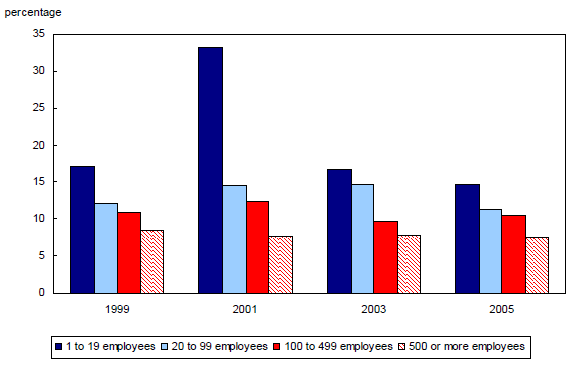
Source: Statistics Canada, Workplace and Employee Survey, Workplace component.
1.2 Job mobility
The WES tracks employees for a period of two years. Various employee flows were studied: employees working for the same employer and at the same job in both years; employees working for the same employer but at different jobs in the second year; employees working for a different employer from the one reported in the baseline year; and employees leaving paid employment in the follow-up year. These flows are compared and studied in relation to a wide array of job and worker characteristics.
Job mobility rate is defined as the number of employees who have changed jobs between the two years of the panel divided by the total number of individuals employed in the first year of the panel.
Overall, job mobility decreased between 1999 and 2004. The proportion of workers changing jobs decreased by 5 percentage points in the 2003 to 2004 employee panel, compared to the 1999 to 2000 employee panel (14.6 % versus 19.7%).
Particularly noticeable was the decline in the proportion of workers changing jobs within their workplaces when the three panels were compared. From 10.9% in the 1999 to 2000 employee panel, intra-workplace mobility decreased by almost 5 percentage points in the 2003 to 2004 employee panel (10.9% versus 6.1%).
Data from the three WES employee panels showed that young workers were more likely to change employers than older ones. For example, 1 in 5 workers under 25 changed employers, versus for workers aged 45 or more about 1 in 20. Not surprisingly, as tenure increased, the likelihood of remaining with the same employer also increased. Of all occupations, marketing and sales, and production workers were most likely to have changed employers.
Table 1.2 Job mobility rates, 1999 to 2000, 2001 to 2002 and 2003 to 2004 employee panels, Canada by age group, sex and occupation.
Chart 1.2
Job mobility in the 1999 to 2000, 2001 to 2002 and 2003 to 2004 employee panels
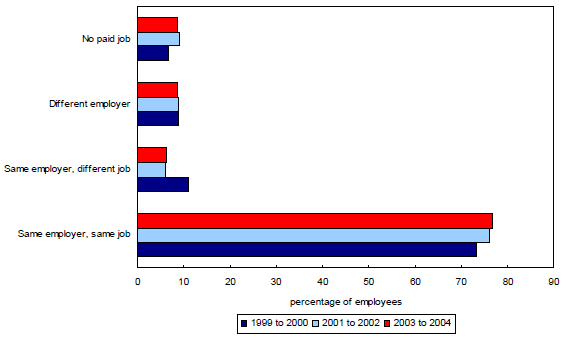
Source: Statistics Canada, Workplace and Employee Survey, Workplace component.
1.3 Occupational mobility
Workers occupations in the first year of the panel were compared to their occupations in the second year. The occupational mobility rate for each panel was calculated as the number of employees who changed occupations between the two years of the panel divided by the number of individuals with paid employment in both years. (Table 1.3)
As with overall job mobility, occupational mobility estimates show increased occupational stability for workers. Between 1999 and 2000, 9.4% of workers had changed occupation, falling to 8.4% between 2003 and 2004.
As age increases, occupational mobility rates decline. It may well be that younger workers, on average, were more willing to change occupations, whereas older workers, having completed their education and invested in training, were less willing to do so.
Turning to differences in occupational mobility by gender, occupational mobility rate was slightly higher for female than for male workers in the first employee panel (9.7% versus 9.0%). This difference grew in the second panel (8.7% versus 6.6%) and narrowed a little bit in the third employee panel (9.1% versus 7.5%). This indicates that female workers had greater occupational mobility rate (i.e., changed occupations more) than their male counterparts in all panels. This, in part, is due to the higher proportion of women engaged in part-time employment. Nevertheless, differences in occupational mobility rates were much larger by age than by sex.
Generally, as tenure and years of experience increase, occupational mobility rates decrease. As would be expected, part-time workers showed greater occupational mobility than their full-time counterparts in all three employee panels.
Chart 1.3
Occupational mobility by work experience in the 1999 to 2000, 2001 to 2002 and 2003 to 2004 employee panels
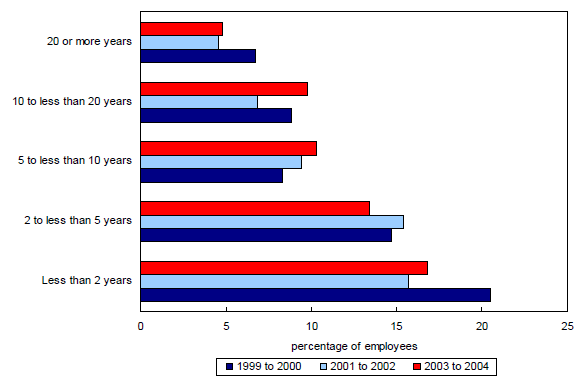
Source: Statistics Canada, Workplace and Employee Survey, Workplace component.
1.4 Work arrangements
Tables 1.4 and 1.5 provide data on the variety and extent of non-standard work arrangements such as reduced work weeks, compressed work weeks, flexible hours and weekend work. The extent of work done at home in the workplaces surveyed is also examined to shed light on issues related to the time pressures faced by employees.
In 2005, 84.0% of workers were full-time workers. Part-time employment was concentrated among women, youth and marketing and sales personnel. (Table 1.4)
The most common form of alternative work arrangement for both sexes was flexible hours. Overall, 37.0% of workers had some flexibility in their hours of work. One-quarter worked weekends.
More men than women reported flexible working hours, but more women tended to work Saturdays or Sundays. University-educated workers had the greatest incidence of flexible hours (43.5%) and seldom had regularly scheduled weekend work hours (17.0%). About 6 out of 10 workers in retail trade and consumer services industry usually worked weekends. This contrasted sharply with workers in the construction and capital-intensive tertiary manufacturing industries, who rarely worked weekends.
Reduced (e.g. job sharing, work sharing, etc.) and compressed work weeks were not widespread work arrangements. The groups with the highest incidence of reduced work weeks were youth, marketing and salespersons and retail trade and consumer services workers.
Chart 1.4
Work schedule by gender, 2005
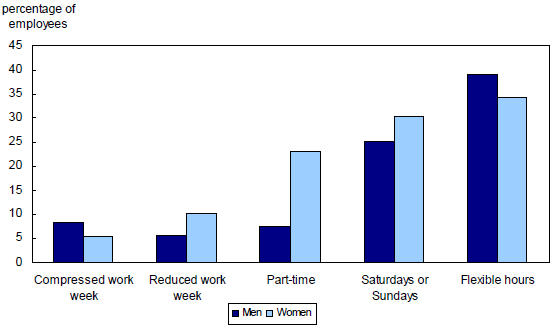
Source: Statistics Canada, Workplace and Employee Survey, Workplace component.
About one-quarter of employees reported doing some work at home in 2005, for the most part without pay and in addition to normal work hours. Receiving pay for overtime worked at home, was uncommon. (Table 1.5)
Workers aged 25 years or more, and those in managerial and professional occupations were most likely to work additional unpaid hours. Unpaid hours worked at home were most common among employees in the education, health services and non-profit organizations, and information and cultural industries.
Over the 1999 to 2005 period, the proportion of workers doing some work at home was consistently higher in workplaces with 500 employees or more. Over the same period work at home also remained preponderant among workers in managerial and professional occupations.
Chart 1.5
Work at home by occupation, 1999, 2001, 2003 and 2005
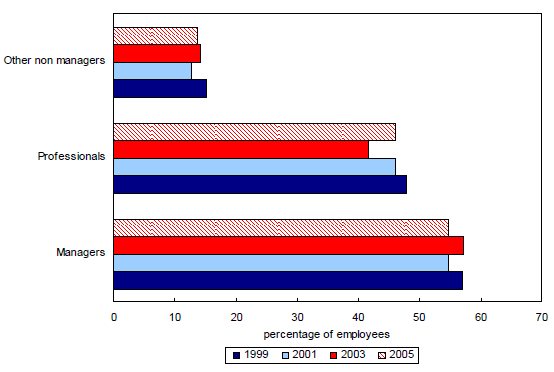
Source: Statistics Canada, Workplace and Employee Survey, Workplace component.
____________
1. In Table 1.1, the employment level of the previous year, (t – 1), has been constrained to agree with reported employment, hirings and separations in the current year, (t), based on the following identity: Employment in (t – 1) ≡ Employment in (t) minus Hirings in (t) plus Separations in (t).Therefore, Net employment change rate ≡ Job creation rate minus Job destruction rate and Net employment change rate ≡ Hirings rate minus Separations rate.
The rates for job and worker flows were computed by using as their denominator the number of employees exposed to the risk of turnover. This number was calculated, in turn, as all those employed at the beginning of the current year plus the number of hires during the current year. Job vacancy rate was defined as the number of vacant positions divided by the total demand for labour, which is the sum of the number of employees at the end of the reference period plus the number of job vacancies during the year.
- Date modified:
